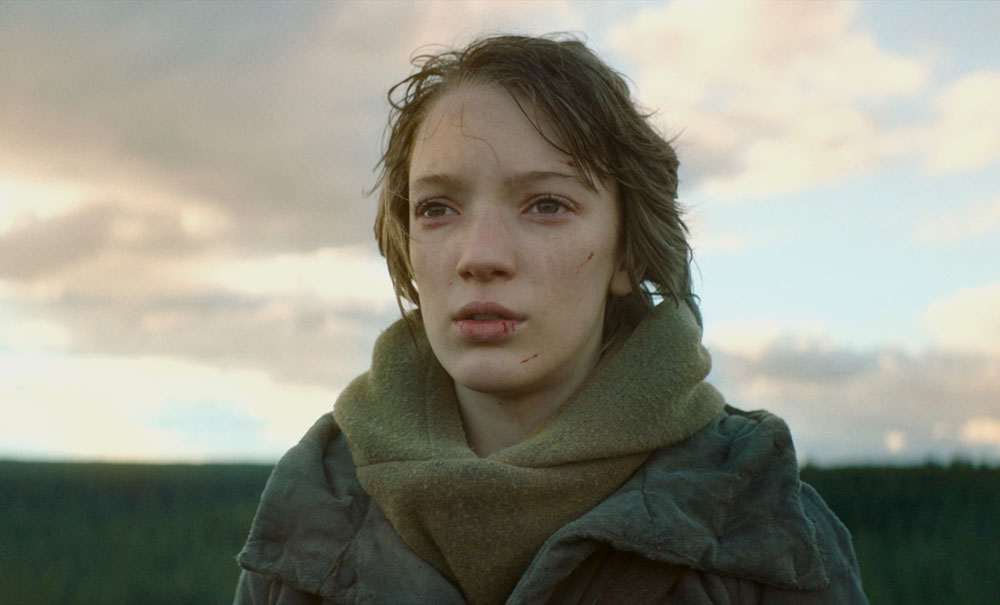When “Vesper” got the green light to go into production as the pandemic continued to wreak havoc on the world with new variants, the scenario that Bruno Samper and Kristina Buozyte, along with their co-writer Brian Clark, had envisioned some time before was coming to life, seeming almost prophetic when they had written about a world of have and have nots where a collection of the rich had hoarded the earth’s resources in a place known as the Citadel, leaving all others to forage for what little remained in the neglected soil. There was no time to waste in getting such a prescient vision to the screen, but the practicalities of setting up a production when the world had changed so radically brought unexpected challenges.
“Everything was made remotely by Zoom,” said Samper, who was left to intuit the perfect ensemble for the film without having everyone gather in the same room before arriving on set. “[The cast] were sending us videos and we were watching the videos and making meetings by Zoom and even a few weeks before the shoot, we didn’t meet the actors in real [life].”
Thankfully, as it can be now seen on screen, the filmmakers have enormous imaginations and “Vesper” is as radically ambitious in its emotional scope as it is in the scale of the production, centering on a survivor of the new world order named Vesper (Raffiella Chapman), who worries less for herself than for the health of her bed-bound father (Richard Brake). In scavenging for food, Vesper and her trusty droid come across something more unexpected than the stray seeds they dig deep for sustenance in Camellia (Rosy McEwen), a woman claiming to have fallen from the Citadel and needs Vesper’s help to return. It isn’t only Vesper who takes an interest in Camiella, but Jonas (Eddie Marsan), who has collected a small army of those left homeless by the changes in the ecosystem and barters goods ranging from pantry supplies to blood to stay afloat after the economy has collapsed.
While Vesper pursues a scientific solution that could lead to a renewed food chain for all, those around her have more selfish aims and the film emerges as a compelling response to a time of environmental crisis in which those who hold the most power are least equipped to meet the demands of the moment when humanity’s extinction seems less pressing than personal concerns. Although Samper and Buozyte draw a clear parallel to the world we live in, the one they create is immersive and — despite its foreboding — enchanting as a biogenetic experiment gone awry has left all sorts of fascinating species in its wake and Vesper’s discoveries as a 13-year-old becoming more acquainted with her surroundings become the audience’s. With the film arriving in theaters this week after a recent celebrated festival run spanning Karlovy Vary, Fantasia Fest and Fantastic Fest, Samper and Buozyte spoke about making a triumphant return to features a decade after their mindbending thriller “Vanishing Waves” and blending the physical grandeur of their native Lithuania with savvy and inventive VFX that affords “Vesper” to punch well above its weight as a sci-fi epic.
Kristina Buozyte: We decided to shoot a movie in Lithuania and then we started to think what are the best things in Lithuania, and it is the nature of Lithuania that’s gorgeous and beautiful, so [we thought thematically of] nature and then came the idea that we want to make a dark, grim fairy tale that is very realistic and shows a post-apocalyptic world.
Bruno Samper: We used a form of fairy tale because as we create the new world, you have to introduce so many rules to the audience [that] if you introduce all those setups and new characters at the same time, you will lose the audience so we were trying to go to the most simple story as possible. Then we can really work more in the detail and to go in depth into the emotion and the world-building because we can rely on these few characters that are very archetypal.
Kristina Buozyte: Because each character was bringing its own themes and problems, it was very interesting not only to look at the story from the plot [perspective], but also from the metaphorical and symbolic perspective and it was like this character talks about this and this [other] character talks about that.
Even the plantlife has a lot of character to it. Was there inspiration behind it?
Bruno Samper: There were many inspirations for this plant. We looked at a lot of documentaries about wildlife and animals, and the inspiration comes from all of the biodiversity in some way, but with a little twist, which is why we wanted each plant to have something human inside. We were imagining there was a little human DNA mixed with the DNA of this plant, so you always see something like skin tone or maybe texture of human skin or behavior – the movement or the way of contact. There something vaguely human in all the plants, and one big challenge for us was we wanted something very strange and very new for the plants, but doesn’t look alien, from another planet. It’s very hard to find something that’s transformed, but it’s something familiar. This was really the artistic challenge to find a good balance and we also worked on the behavior of the plant on two very simple principles – breathing and pulsating, these two basic organic animation we have, so we are putthat on the plant and we think it gives some unity [to the world we created].

Bruno Samper: Everything was being made by Zoom [beforehand], so [the casting agency] sent us a bunch of video and we really clung on Raffiella [immediately] because she has something [inherent as part of] the Z generation, this mix of sensitivity and strength and determination, and when we wrote the character of Vesper, she was a little bit more rough in the script because she lived in the [wild] and Raffi was able to bring more layers to the character, this fragility and sensitivity that wasn’t expected. Vesper was really more interesting like that.
Kristina Buozyte: Of course, British actors are the best and we had a super great talents like Eddie Marsan, who has such huge experience, and Rosy McEwen, who’s just pure talent. She can do everything and she just goes inside and it just depends on what button you can press and she provides you a big, big palette of emotion, so it was so interesting to work with them, and to see this dynamic between [all of] them. All the actors were very generous and not only [with their time] in rehearsals and on set, but they were generous also for each other and for their characters, so each actor pushed really the borders of the characters that we couldn’t even imagine. It was the same with Richard Brake, [who’s typically] known as a bad guy, and here he was as a loving father and so sincere. He has three kids at home and he brought all of this life and warmth that we haven’t seen before, so there were many surprises.

Kristina Buozyte: It was very interesting, and our big challenge and our big bet because we needed to build a real flying drone that we could control…
Bruno Samper: It was our BB-8 challenge. [laughs]
Kristina Buozyte: And our Lithuanian team worked seven months from the drawing to the flying ball because when we started, we didn’t know if it can fly, how it will be controlled and if we can film it for real. In fact it was four different drones on set – it was a flying one, a drone on a rig, a drone you could carry and do something and after it was a jag drone. It was very funny because recently we watched the movie with our [cinematographer] and he said, “You know what? I don’t know which drone is real and which is not.” [laughs] So it was really a big achievement of our visual FX house and visual FX crew who made it real in each shot.

Bruno Samper: Yeah, it’s not only a question of [time]. It’s a question of budget also and if you have big ambition and not a big budget, you need time and then yes, the post-production was about one year. It was pretty intense, but we have four VFX companies, three in France and one in Belgium and all the companies were totally committed to the movie because they don’t have a chance every day in Europe to work on sci-fi movies. It was really a passion project.
Kristina Buozyte: Yes, without passion of the team at each step of this movie – on set for production, the costumes, sound, effects, it wouldn’t be as it is. The budget was very constrained, but we were blessed with luck and really blessed with the team who gave much more. It was somehow an inner challenge that they could make this movie to be proud of and I can say they are really proud.
“Vesper” opens on September 30th in theaters, including the IFC Center in New York and the Laemmle Glendale in Los Angeles, and on demand.





